Failure Behavior Attributed to Internal Erosion Caused by Conduit Cracks in Homogeneous Embankment
Abstract
:Featured Application
Abstract
1. Introduction
- (a)
- Long-term internal erosion owing to material anisotropy occurring at the conduit boundary and fill zone (e.g., the Sandae Reservoir) [11];
- (b)
- (c)
- The outer part of the conduit may be surrounded by a clay layer for the purpose of reducing the water pressure applied to the conduit. However, at the soil–structure interface, an increase in the degree of compaction and in the clay content can lead to a more severe failure due to the increase in the critical hydraulic gradient [11].
2. Materials and Methods
2.1. Model Reservoir
- (a)
- For the model embankment, only soils that passed through a 12 mm sieve were used to ensure that the specimens could be laid homogenously. Additionally, the compaction moisture content was adjusted to the optimal moisture content (14 ± 2%);
- (b)
- To achieve a uniform density, each layer had an approximate thickness of 10 cm, and the compaction was made with a vibrating machine (frequency: 9000–12,000, 50 Hz) until approximately 90% of the maximum dry density was reached.
2.2. Measurement Location and Experimental Conditions
3. Results and Discussion
3.1. Embankment Failure Shape
- (a)
- Leakage due to the presence of conduit defects primarily weakens the strength of the downstream slope. Accordingly, when secondary overtopping occurs, the slope failure can be accelerated;
- (b)
- From a disaster warning and response point of view, a failure due to the presence of conduit defect may allow for more adverse conditions to respond to a disaster than failure due to the fact of overtopping.
3.2. Pore-Water Pressure (PWP) Variations
3.3. Finite Element Analysis
3.3.1. PWP via Finite Element Analysis
3.3.2. Hydraulic Gradient via Finite Element Analysis
3.3.3. Settlement Comparison Based on the Experiment and Analysis
3.3.4. Disaster Response Review
4. Conclusions
- An increase in the erosion depth is an important indicator that embankment failure, owing to the expansion of the slope failure, is imminent. However, because the erosion depth increases over a very short period of time, measurement methods are limited in their ability to detect rapid changes. This suggests that applying pre-reinforcement to the slope can be an effective method for suppressing the erosion depth, and discussions regarding the reinforcement method at the top of the conduit are necessary. The model experiment results can provide basic data on how to repair and reinforce the conduit of the deteriorated reservoir. They can also be used to identify the piping mechanism in the conduit and predict the possibility of failure;
- The pore-water pressure and settlement were measured, and the results indicate that they exhibited abrupt decreases and increases at the time of embankment failure, respectively. All the measured values generally corresponded to the time at which failure occurred. The pore-water pressure increased slightly as piping progressed, and then decreased rapidly as the dam crest failed. The differences in pore-water pressures above and below the conduit were determined to be attributed to seepage, and the likelihood of internal erosion was greater in regions above the conduit. The pore-water pressure above the conduit continuously increased, even though the water level within the embankment reached a steady state. This may have created a critical region for internal erosion. In the downstream conduit position, the time over which the pore-water pressure decreased was slightly shorter than in other locations; hence, failure occurred very fast at this location;
- The hydraulic gradients were distributed below the conduit and gradually extended toward the regions above the conduit of the downstream slope. The results indicate that piping above the conduit near the downstream slope was likely. The stability of the piping owing to the conduit leakage was evaluated by the critical hydraulic gradient. The exit hydraulic gradient in the risk zone of the downstream slope was in the range of 0.5–0.75, and the stability of the embankment was smaller than the reference safety factor (SF = 2.0). By tracking the vulnerable areas of the slope based on the hydraulic gradient distribution and the experimental results, it was determined that a potential failure surface could be formed at heights equal to 1.4–2.4 times (h2) the height (h1) of the downstream side’s conduit;
- Reviewing the settlement in the analysis, it was found that the settlement was concentrated in the central zone of the embankment where the conduit was located. Under these conditions, if the increase in PWP and the action of self-weight continue in the central zone of the embankment, it is presumed that it will be the first risk area that threatens the stability of the embankment;
- The evaluation of the time of failure based on the experimental and analysis results and the amount of water storage capacity in the Sandae Reservoir indicated that the measurement method (settlement and water storage capacity) was less sensitive to deformation changes than the monitoring method. Given that time is crucial for responding to a disaster caused by a reservoir failure, an automated monitoring system that can immediately identify the deformation of the downstream slope can be a suitable method for rapid disaster warning;
- Based on the results, it was found that the amount of settlement in the dam crest and the time that is expected to elapse before failure can provide significant insights into the type of pre-reinforcement required to prevent or minimize the failure of the dam crest due to the fact of conduit leakage.
Author Contributions
Funding
Institutional Review Board Statement
Informed Consent Statement
Data Availability Statement
Acknowledgments
Conflicts of Interest
References
- Vallejo, S.A.N. Hydraulic Engineering Failures of Large Dams. Master’s Dissertation, Civil Engineering Construction University of Porto, Porto, Portugal, June 2016; p. 42. Available online: https://repositorioaberto.up.pt/bitstream/10216/84171/2/136712.pdf (accessed on 16 May 2022).
- Foster, M.A.; Fell, R.; Spannagle, M. The statistics of embankment dam failures and accidents. Can. Geotech. J. 2000, 37, 1000–1024. [Google Scholar] [CrossRef]
- Fell, R.; Wan, C.F.; Cyganiewiewicz, J.; Foster, M. Time for development of erosion and piping in embankment dams. J. Geotech. Geoenviron. Eng. 2003, 129, 307–314. [Google Scholar] [CrossRef]
- Wan, C.F.; Fell, R. Investigation of rate of erosion of soils in embankment dams. J. Geotech. Geoenviron. Eng. 2004, 130, 373–380. [Google Scholar] [CrossRef]
- Hanson, G.J.; Cook, K.R.; Hunt, S.L. Physical modeling of overtopping erosion and breach formation of cohesive embankments. Trans. ASAEB 2005, 48, 1783–1794. [Google Scholar] [CrossRef]
- Jandora, J.; Řiha, J. The Failure of Embankment Dams Due to Overtopping; Brno University of Technology: Brno, Czechia, 2009. [Google Scholar]
- Alhasan, Z.; Jandora, J.; Říha, J. Study of dam-break due to overtopping of four small dams in the Czech Republic. Acta Univ. Agric. Silvic. Mendel. Brun. 2015, 63, 717–729. [Google Scholar] [CrossRef] [Green Version]
- Zhao, M.; Liu, P.; Jiang, L.; Wang, K. The Influence of Internal Erosion in Earthen Dams on the Potential Difference Response to Applied Voltage. Water 2021, 13, 3387. [Google Scholar] [CrossRef]
- Richards, K.S.; Reddy, K.R. Critical appraisal of piping phenomena in earth dams. Bull. Eng. Geolog. Environ. 2007, 66, 381–402. [Google Scholar] [CrossRef]
- Hunt, S.L.; Hanson, G.J.; Cook, K.R.; Kadavy, K.C. Breach widening observations from earthen embankment tests. Trans. ASABE 2005, 48, 1115–1120. [Google Scholar] [CrossRef]
- Xie, Q.Y.; Liu, J.; Han, B.; Li, H.T.; Li, Y.Y.; Jiang, Z.Q. Experimental investigation of interfacial erosion on culvert-soil interface in earth dams. Soils Found. 2018, 59, 671–686. [Google Scholar] [CrossRef]
- Ojha, C.S.P.; Singh, V.P.; Adrian, D.D. Influence of porosity on piping models of levee failure. J. Geotech. Geoenviron. Eng. 2001, 127, 1071–1074. [Google Scholar] [CrossRef]
- Ojha, C.S.P.; Singh, V.P.; Adrian, D.D. Determination of critical head in soil piping. J. Geotech. Geoenviron. Eng. 2003, 129, 511–518. [Google Scholar] [CrossRef]
- Ali, A.A.; Hunt, S.L.; Tejral, R.D. Embankment Breach Research: Observed Internal Erosion Processes. Trans. ASABE 2021, 64, 745–760. [Google Scholar] [CrossRef]
- Lee, Y.H.; Ryu, J.H.; Heo, J.; Shim, J.W.; Lee, D.W. Stability improvement method for embankment dam with respect to conduit cracks. Appl. Sci. 2022, 12, 567. [Google Scholar] [CrossRef]
- Lee, Y.H.; Park, S.Y.; Tokida, K.I.; Lee, D.W. Three-dimensional seepage characteristics of reservoir embankment considering interval of horizontal filter. Int. J. Offshore Polar Eng. 2018, 28, 80–86. [Google Scholar] [CrossRef]
- Reddi, L.N.; Bonala, M.V. Filtration and drainage in geotechnical/geoenvironmental engineering. In Proceedings of Sessions of Geo-Congress 98; American Society of Civil Engineers: Reston, VA, USA, 1998. [Google Scholar]
- Mousavian, S. Seepage Monitoring and Diagnosis of Distresses in an Earth Embankment Dam Using Probability Methods; New Jersey Institute of Technology: Newark, NJ, USA, 2017. [Google Scholar]
- MIDAS IT. Midas Geotechnical and Tunnel Analysis System (Midas GTS). 2020. Available online: https://www.midasgeotech.com/blog/tag/geotechnical-engineering (accessed on 20 October 2020).
- Carsel, R.; Parrish, R. Developing joint probability distributions of soil water retention characteristics. Water Res. Res. 1988, 24, 755–769. [Google Scholar] [CrossRef] [Green Version]
- USSD. The Aging of Embankment Dams. 2010. Available online: https://www.ussdams.org/wp-content/uploads/2016/05/aging.pdf (accessed on 20 October 2020).
- Ke, L.; Takahashi, A. Strength reduction of cohesionless soil due to internal erosion induced by one-dimensional upward seepage flow. Soils Found. 2012, 52, 698–711. [Google Scholar] [CrossRef] [Green Version]


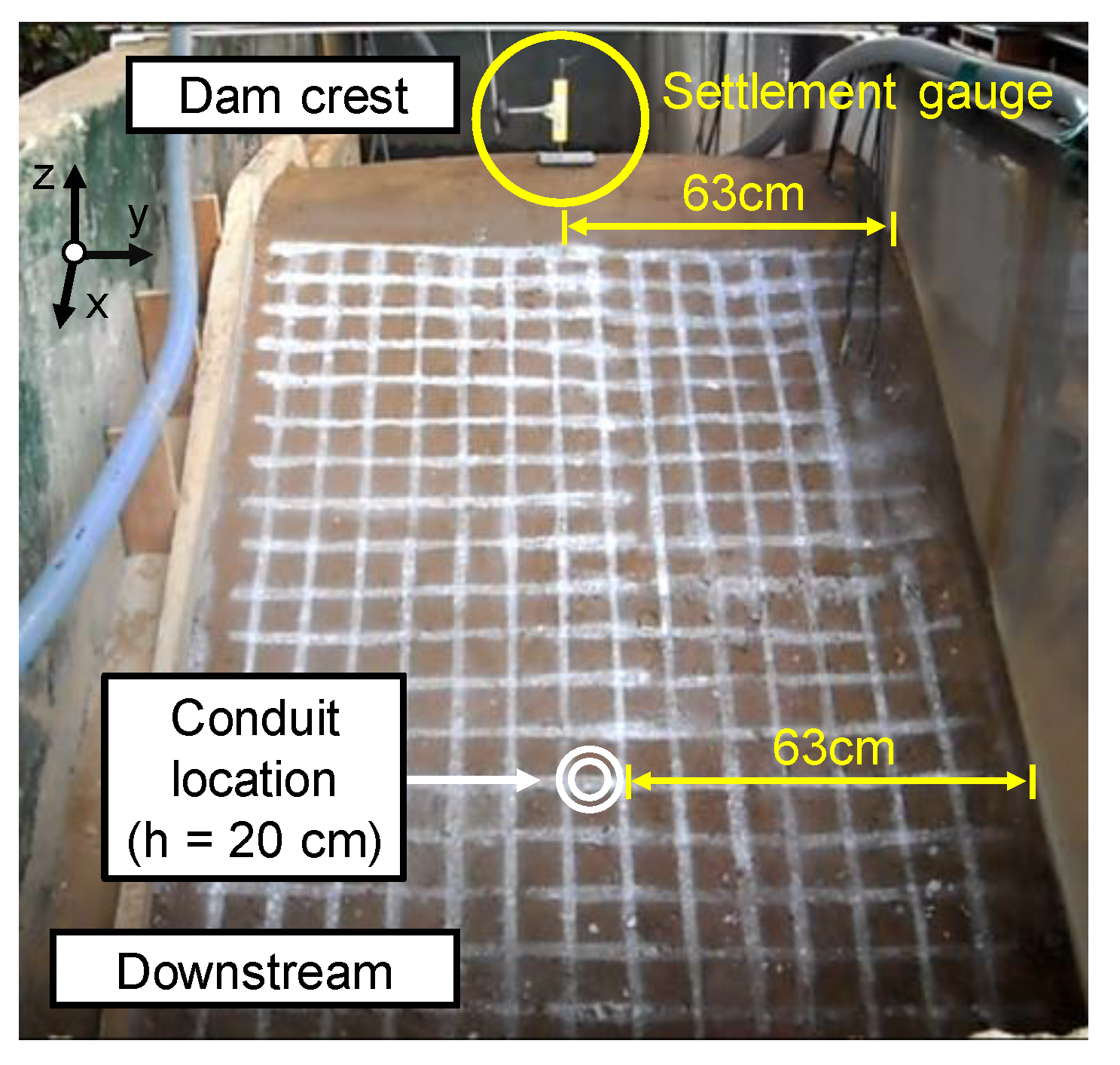



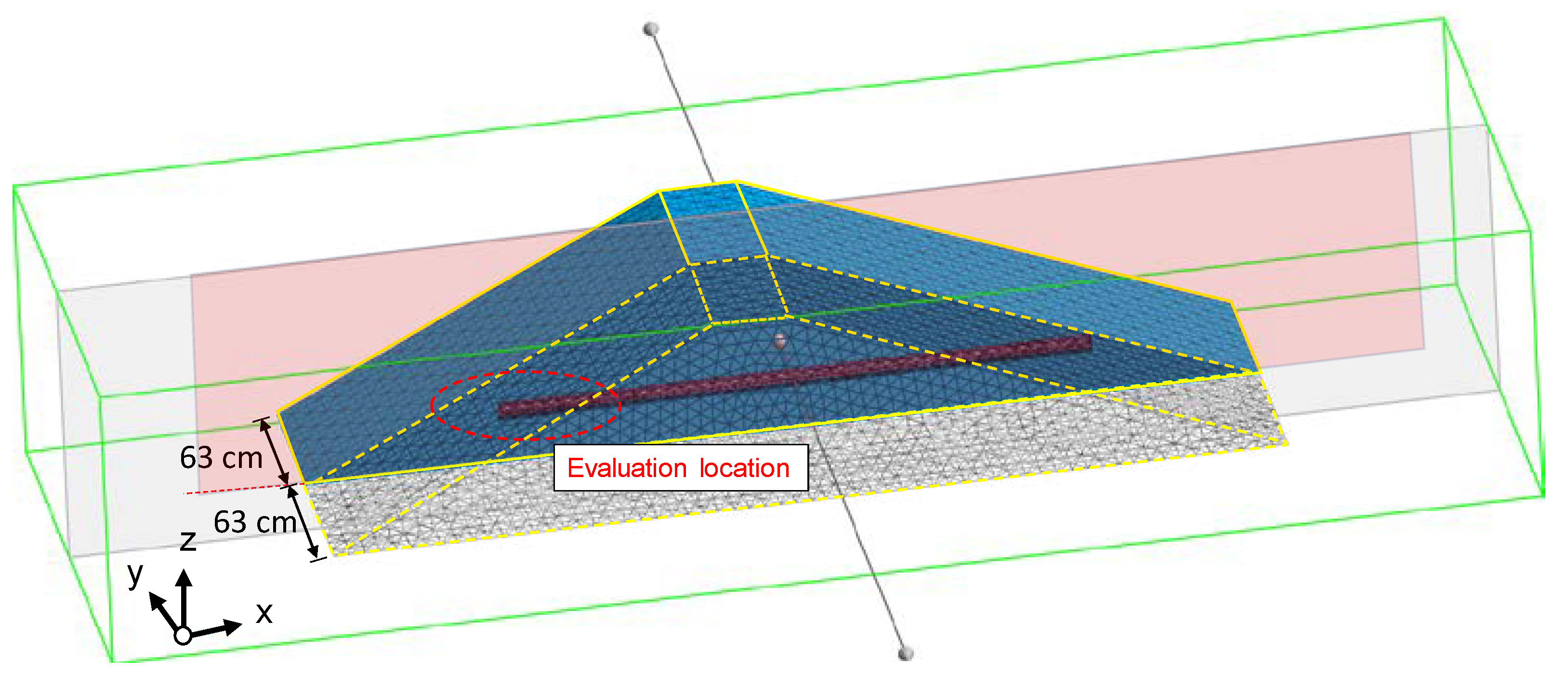
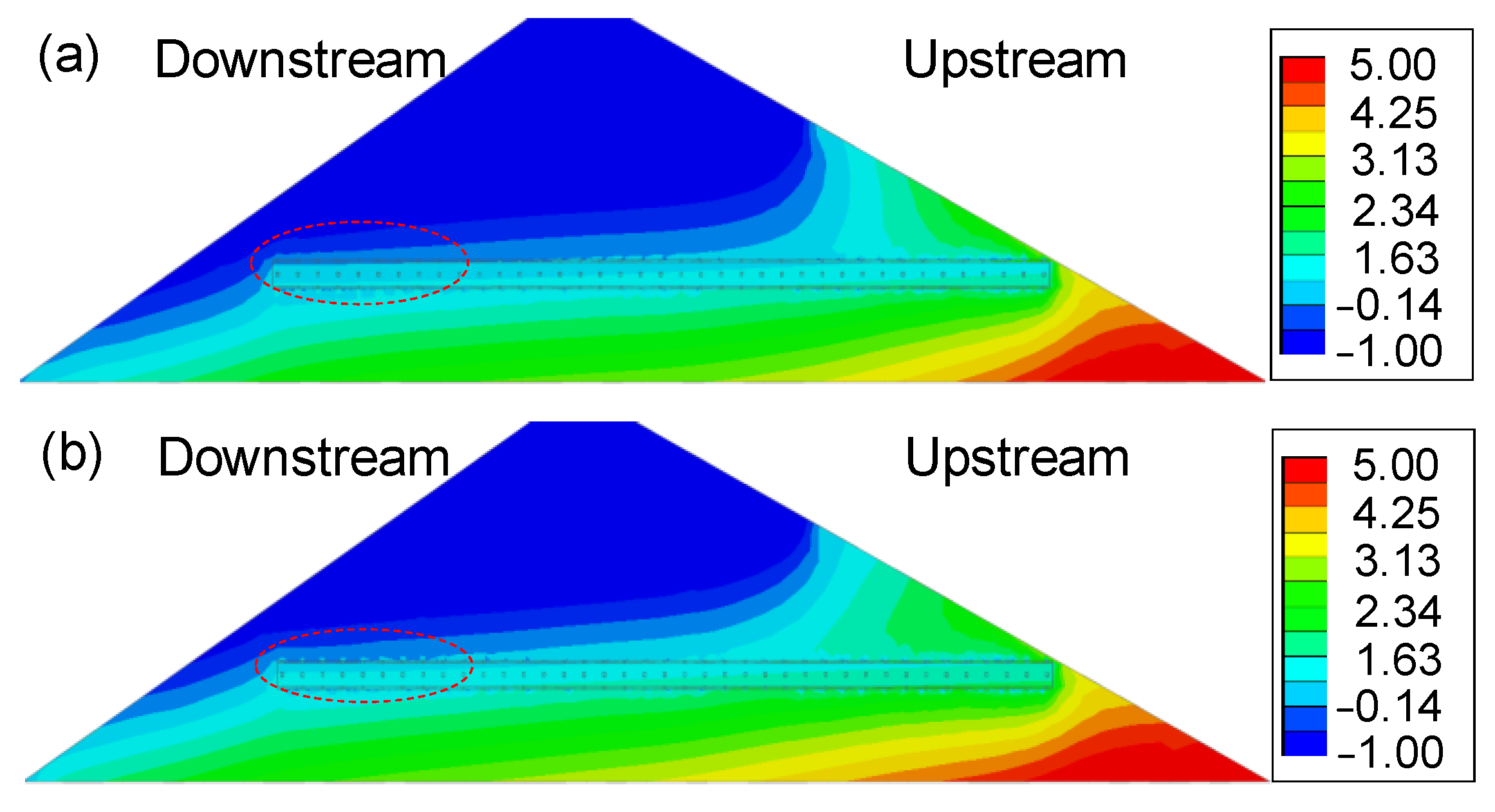
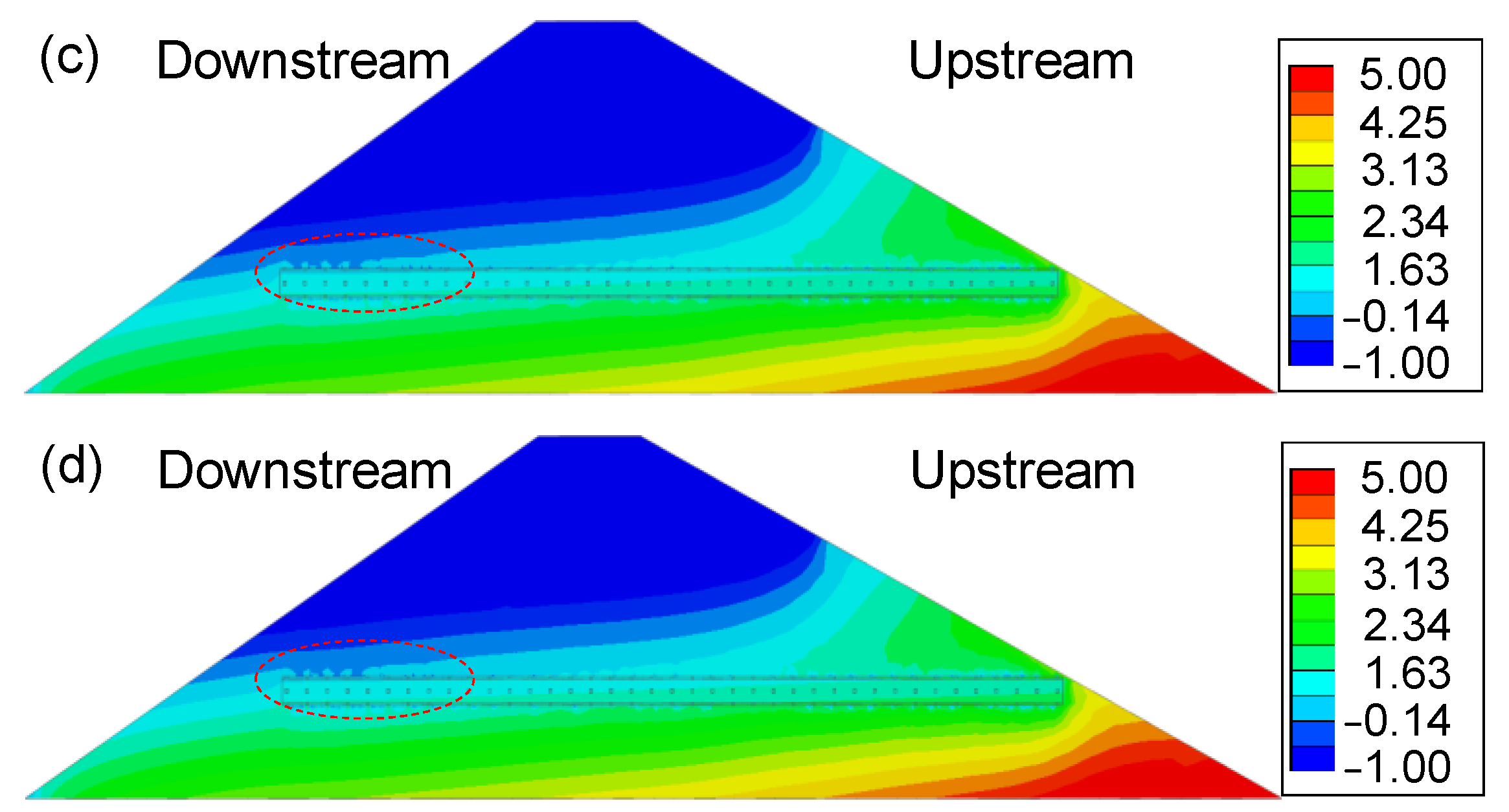

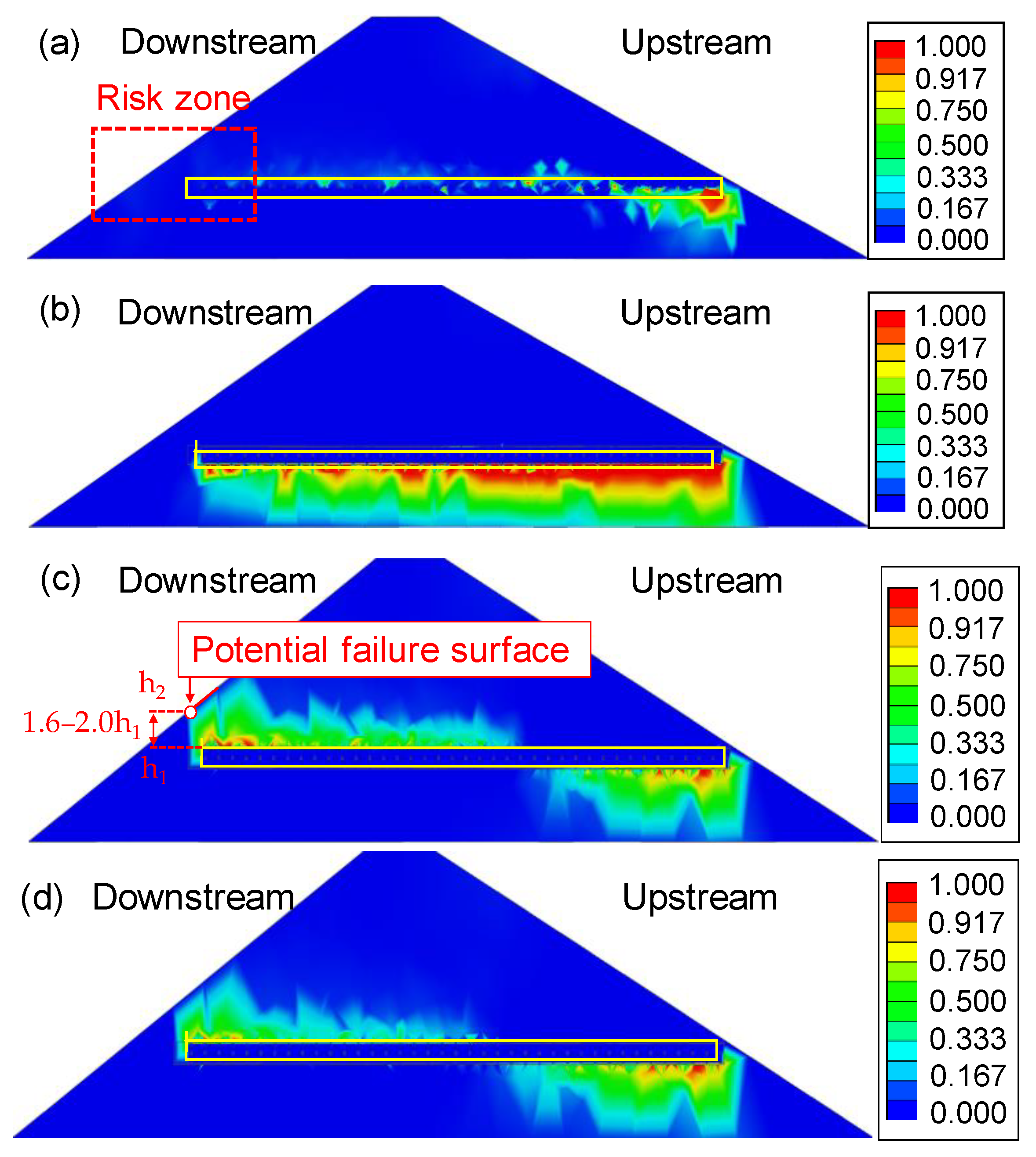

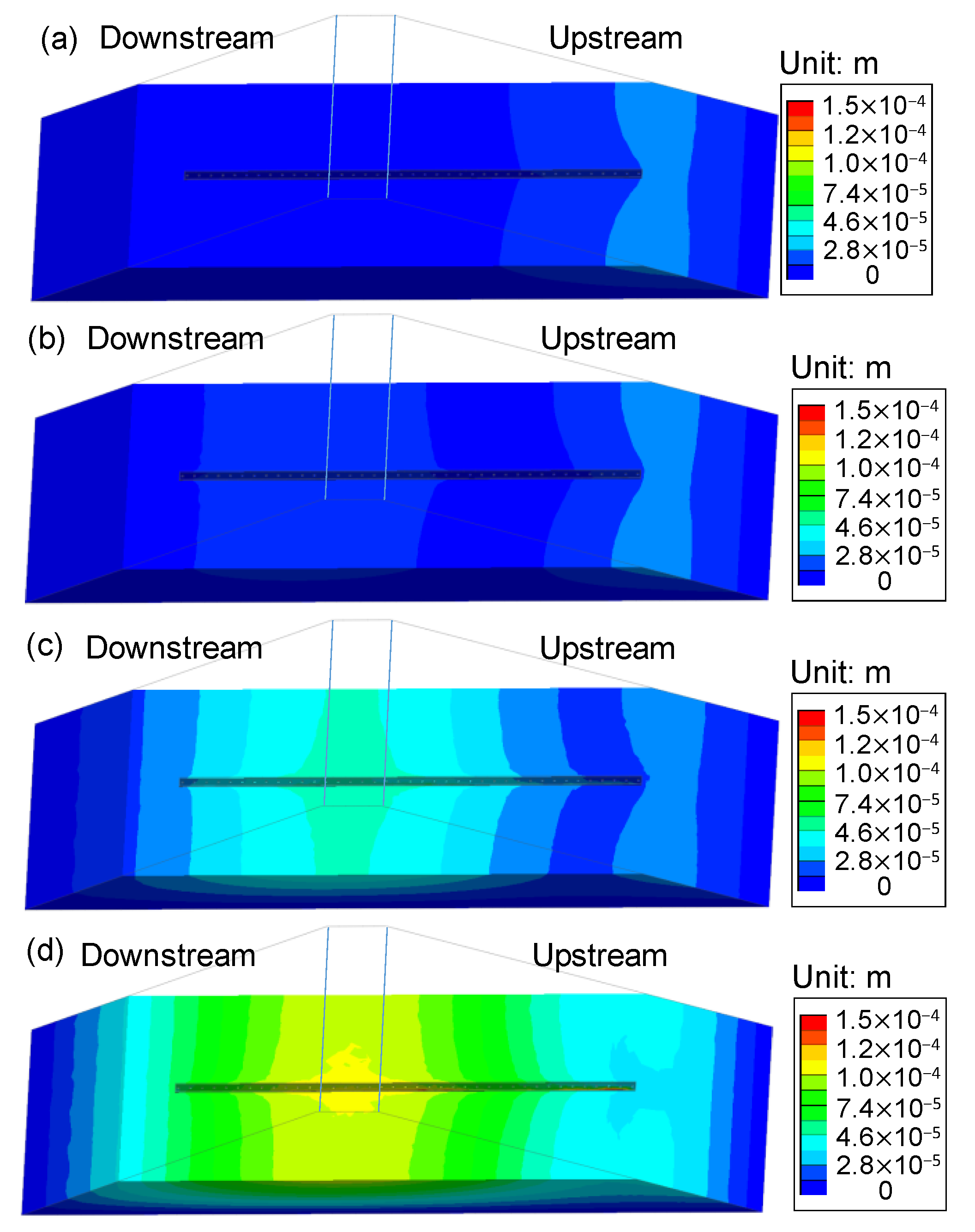

| Sample | Gs | PI (%) | k (m/s) | Wopt (%) | (kN/m3) | c (kPa) | ø | USCS |
|---|---|---|---|---|---|---|---|---|
| Embankment | 2.65 | 9.2 | 2.32 × 10−6 | 14.0 | 17.25 | 16.7 | 24 | CS |
| Stage | t (min) | Results |
|---|---|---|
| (a) Initial deformation | 155 | An oval-shaped failure occurred on the slope and tension cracks occurred on the dam crest |
| (b) Progress | 157 | The deformation area rapidly expanded on the slope |
| (c) Rapid development | 158 | The deformation area reached the dam crest |
| (d) Dam crest failure | 165 | Failure occurred around the tension cracks on the dam crest |
| (e) Overflow | 168 | Overflow began and failure occurred on the downstream slope |
| (f) Embankment failure | 180 | The entire embankment failed as the overflow amount gradually increased |
| Sample | ν | (kPa) | (m/s) | ||
|---|---|---|---|---|---|
| Embankment | 0.35 | 0.48 | 16.7 | 24 | 2.32 × 10−6 |
| Sample | |||||
|---|---|---|---|---|---|
| Embankment | 0.46 | 0.034 | 1.6 | 1.37 | 0.270 |
Publisher’s Note: MDPI stays neutral with regard to jurisdictional claims in published maps and institutional affiliations. |
© 2022 by the authors. Licensee MDPI, Basel, Switzerland. This article is an open access article distributed under the terms and conditions of the Creative Commons Attribution (CC BY) license (https://creativecommons.org/licenses/by/4.0/).
Share and Cite
Lee, Y.-H.; Ryu, J.-H.; Lee, T.-H.; Shim, J.-W.; Kim, C.-H.; Lee, D.-W. Failure Behavior Attributed to Internal Erosion Caused by Conduit Cracks in Homogeneous Embankment. Appl. Sci. 2022, 12, 6305. https://doi.org/10.3390/app12136305
Lee Y-H, Ryu J-H, Lee T-H, Shim J-W, Kim C-H, Lee D-W. Failure Behavior Attributed to Internal Erosion Caused by Conduit Cracks in Homogeneous Embankment. Applied Sciences. 2022; 12(13):6305. https://doi.org/10.3390/app12136305
Chicago/Turabian StyleLee, Young-Hak, Jung-Hyun Ryu, Tae-Ho Lee, Jae-Woong Shim, Cheol-Han Kim, and Dal-Won Lee. 2022. "Failure Behavior Attributed to Internal Erosion Caused by Conduit Cracks in Homogeneous Embankment" Applied Sciences 12, no. 13: 6305. https://doi.org/10.3390/app12136305






